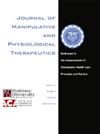Efficacy of Myofascial Release With Transcutaneous Electrical Nerve Stimulation Conductive Glove for Neck Myofascial Syndrome: A Randomized Clinical Trial Study
IF 1.4
4区 医学
Q4 HEALTH CARE SCIENCES & SERVICES
Journal of Manipulative and Physiological Therapeutics
Pub Date : 2023-06-01
DOI:10.1016/j.jmpt.2024.02.008
引用次数: 0
Abstract
Objective
The purpose of this study was to assess the efficacy of a myofascial release (MR) protocol applied with a transcutaneous electrical nerve stimulation (TENS) conductive glove.
Methods
Eighty individuals with neck myofascial syndrome were randomly divided into 4 groups: (1) MR protocol with a TENS conductive glove (MR+TENS), (2) MR protocol without TENS (MR), (3) conventional TENS protocol (TENS), and (4) placebo TENS (control). All participants attended 6 sessions over a period of 3 weeks. The following measures were evaluated at baseline, at the third week, and at the 1-month follow-up: Pain with the visual analog scale (VAS pain), upper trapezius pressure pain threshold (PPT) with pressure algometry, cervical range of motion (ROM) with goniometry, and disability with the neck disability index (NDI). A 2-way ANOVA with repeated measurements was applied.
Results
Significant changes between the 3 intervention groups and the control group were noted in the VAS and the NDI scores (P < .05) with the MR+TENS group exhibiting the biggest difference. Additionally, MR significantly increased PPT compared to TENS, and even further when applied with the conductive glove (P < .05). Regarding lateral flexion ROM, MR was equally effective either alone or in combination with the glove compared to TENS (P < .05). In contrast, TENS did not appear to affect neck PPT and ROM (P > .05). Finally, no difference between the groups was detected in cervical rotation ROM (P > .05).
Conclusion
The MR protocol appears to be more effective in dealing with pain, disability, and lateral flexion ROM than conventional TENS. A TENS conductive glove significantly improves the effects of MR, possibly due to the combined mechanical and electrical stimulation of the muscle.
经皮神经电刺激导电手套治疗颈部肌筋膜综合征的肌筋膜松解疗效:随机临床试验研究。
研究目的本研究旨在评估使用经皮神经电刺激(TENS)传导手套的肌筋膜松解(MR)方案的疗效:80名颈部肌筋膜综合征患者被随机分为4组:(1) 带有经皮神经电刺激传导手套的肌筋膜松解疗法(MR+TENS);(2) 不带经皮神经电刺激的肌筋膜松解疗法(MR);(3) 传统的经皮神经电刺激疗法(TENS);(4) 安慰剂经皮神经电刺激疗法(对照组)。所有参与者均在 3 周内接受了 6 次治疗。在基线、第三周和随访 1 个月时对以下指标进行了评估:疼痛(采用视觉模拟量表(VAS pain))、斜方肌上部压痛阈值(PPT)(采用压力测角法)、颈椎活动范围(ROM)(采用动态关节角度计)和残疾(采用颈部残疾指数(NDI))。采用重复测量的双向方差分析:结果:3 个干预组和对照组的 VAS 和 NDI 评分均有显著变化(P < .05),其中 MR+TENS 组的差异最大。此外,与 TENS 相比,MR 能明显增加 PPT,而与导电手套一起使用时,PPT 的增加幅度更大(P < .05)。在侧屈 ROM 方面,与 TENS 相比,MR 单独使用或与手套结合使用的效果相同(P < .05)。相反,TENS 似乎对颈部 PPT 和 ROM 没有影响(P > .05)。最后,两组在颈椎旋转 ROM 方面没有发现差异(P > .05):结论:与传统的 TENS 相比,MR 方案在治疗疼痛、残疾和侧屈 ROM 方面似乎更有效。TENS导电手套可明显改善MR的效果,这可能是由于对肌肉进行了机械和电刺激。
本文章由计算机程序翻译,如有差异,请以英文原文为准。
求助全文
约1分钟内获得全文
求助全文
来源期刊
CiteScore
3.00
自引率
7.70%
发文量
63
审稿时长
29 weeks
期刊介绍:
The Journal of Manipulative and Physiological Therapeutics (JMPT) is an international and interdisciplinary journal dedicated to the advancement of conservative health care principles and practices. The JMPT is the premier biomedical publication in the chiropractic profession and publishes peer reviewed, research articles and the Journal''s editorial board includes leading researchers from around the world.
The Journal publishes original primary research and review articles of the highest quality in relevant topic areas. The JMPT addresses practitioners and researchers needs by adding to their clinical and basic science knowledge and by informing them about relevant issues that influence health care practices.

 求助内容:
求助内容: 应助结果提醒方式:
应助结果提醒方式:


